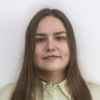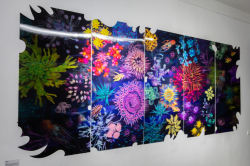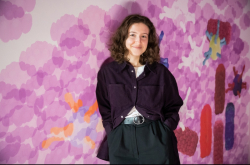Humans as the common point
On display are creations by eight artists who turned to new technologies, analog devices, and everyday objects as their tools and materials: you’ll find exhibits with VR elements, motion capture and ultrasound sensors, as well as TVs and headphones. All of these help uncover new ways to interact with smart devices, expanding our preconceptions about an individual's place in the digital reality.
“We saw humans as the common point between the projects of the Art & Science Center and Yandex Museum. Our bodies, according to the exhibition’s main concept, are tools for collecting information about the world; information that we process in the brain. In their turn, technologies also use special sensors to gain information about their surroundings – and then process the data with their digital “brain.” That’s what makes our sensory system similar to that of a machine,” explains the exhibition’s curator Khristina Ots.
According to the organizers, the exhibited projects also work with human senses, expanding the body’s capabilities. This way, art can demonstrate how technologies help us achieve something we couldn’t achieve before.
New horizons of perception
BREAK-IN is the installation that, according to its creators, is an attempt to visualize the concept of “information overload” and demonstrate how it has changed over the past decades. Visitors see three oscilloscopes (devices used to record, measure, and visualize electric signals) process an audio signal from a computer in real time. The same sound is broadcasted to the headphones attached to each device. Through these, visitors can hear 60 original pieces of varied length and emotional valence. Thus, you get to experience noise and try to identify the audiovisual associations it evokes. The audio was created using AI-generated fragments, as well as excerpts from old radio and phone calls and field recordings.
“The piece’s core concept is the idea that information networks, currently overflowing with data and forming a complex system, have turned into active participants in communication that broadcast new information – as opposed to being mere carriers of it. When interacting with the installation, visitors act as researchers, trying to find meaning in this new data,” says Alexander Pogrebnyak, a media artist, photographer, engineer, and winner of the national competition Science.Technology.Art.

Alexander Pogrebnyak. Photo by Nikolay Kazeev
The installation’s revealing moniker, BREAK-IN, conveys its purpose to investigate information noise from within the phenomenon.
The author of another exhibit, Behind the Looking Glass, invites the audience to “hack” the way they think about their own body. On view is a mirror, which instead of the observer, reflects their digital avatar. The display consists of a computer, a motion capture sensor, and a screen. Visitors may try on five avatars, including a binary code human, a robot, a wolf, a stool, or an abstraction.
“A software that mimics the observer's actions animates the digital skeleton of avatars in real time and thus creates the effect of mirror reflection. With this piece, I aimed to demonstrate that the human body doesn’t transport into a virtual reality but rather, much like anything on a computer, gets converted into a binary code before taking any shape,” says Veronika Kislova, a media artist and a student of the ITMO’s Master’s program Art & Science.
The AcCord project, in its turn, shows the audience how human embryos perceive the world. To experience this, visitors only need to touch the multimedia installation imitating the umbilical cord; it includes corrugated tubes that are illuminated from the inside and transmit sound vibrations.
“As the viewer approaches the front of the umbilical cord, the infrared sensor captures the movement, setting off a four-minute sequence of lights and sounds. Each section of the artwork focuses on a separate stage of embryo development, from the first heartbeat till birth. Vibrations near the tip of the umbilical cord mimic the mother and child's heart rhythms, and audio compositions that incorporate noises, as well, recreate the sound environment similar to that of the embryo. This artwork reflects not only on life and death – but also the role of women in society,” notes Danila Logvinenko, an interdisciplinary artist, a graduate of ITMO’s Master’s program Art & Science, and a laureate of the Tavrida and Astra awards.

AcCord. Photo by Nikolay Kazeev
The exhibition is on until June 12. Visitors can explore the exhibits on their own on weekdays or as part of a tour by the display’s curators on weekends. Entry is free. The event also features lectures, workshops, and contemporary art talks – the program is available on the exhibition’s website.













